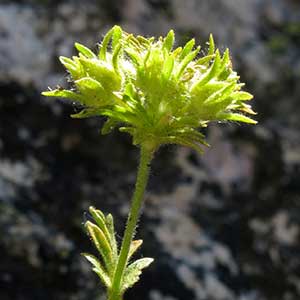Ivesia longibracteata
Ivesia callida
Castle Crags ivesia, longbract mousetail
Tahquitz ivesia, Tahquitz mousetail
ascending to erect, 0.3–1.2 dm.
usually pendent or prostrate to ascending, sometimes nearly erect, 0.2–1.5 dm.
weakly planar to loosely ± cylindric, (0.5–)2–4(–6) cm; sheathing base glandular abaxially, otherwise glabrous;
petiole 0.5–2 cm, hairs 0.2–1 mm;
leaflets 5–6 per side, 2–6 mm, ± short-hirsute, glandular-puberulent, lobes 2–7, oblanceolate to spatulate or obovate, apex not setose.
± loosely cylindric to weakly planar, 1–7 cm; sheathing base sparsely strigose abaxially;
petiole 0.3–3 cm;
lateral leaflets (1–)5–8 per side, slightly overlapping, elliptic to flabellate, 2–6(–7) mm, incised nearly to base into (0–)2–4 oblanceolate to elliptic lobes, apex sometimes ± setose, surfaces loosely long-strigose, sparsely glandular;
terminal leaflets indistinct.
1–3, not paired.
(1–)2;
blade reduced.
3–14-flowered, 1–2.5 cm diam.;
glomerules 1.
1–10(–15)-flowered, open, (0.5–)2–5 cm diam.
1.5–6 mm.
5–15 mm.
8–10 mm diam.;
epicalyx bractlets linear to narrowly lanceolate or elliptic, 2.5–5 mm, longer than sepals;
hypanthium shallowly cupulate, 0.5–1 × 2–3 mm;
sepals 1.5–2.5 mm, ± acute;
petals pale yellow, linear to narrowly oblanceolate, 1.5–2.5 mm;
stamens 5, filaments 0.7–1.3 mm, anthers yellow, 0.5–0.8 mm;
carpels 6–11, styles 1–1.5 mm.
7–10 mm diam.;
epicalyx bractlets 5, narrowly lanceolate, 1.5–3 mm;
hypanthium patelliform, 0.5–1 × 2–3 mm;
sepals 2–3.5 mm, acute;
petals white, obovate, 2–3.5 mm;
stamens 20, filaments 1.5–3 mm, anthers maroon, subrotund, 0.2–0.3 mm;
carpels 4–8, styles 1.5–1.8 mm.
cream to light tan, 1.2–1.5 mm.
greenish white to light tan, 1.5 mm, smooth to lightly rugose, ± carunculate.
Ivesia longibracteata
Ivesia callida
Of conservation concern.
Ivesia longibracteata is known only from the Castle Crags area of Shasta County. The epithet alludes to a diagnostic characteristic unique in the genus: the epicalyx bractlets are longer than the sepals. The plants grow on vertical rock faces, a habitat more characteristic of sect. Setosae; however, the stems are ascending to erect and do not form hanging clumps, and the pedicels are not curved in fruit.
(Discussion copyrighted by Flora of North America; reprinted with permission.)
Of conservation concern.
Ivesia callida occurs in the Tahquitz Peak area of the San Jacinto Wilderness Area, San Jacinto Mountains, Riverside County, where two populations are known (K. Berg 1983). Plants form tight mats in horizontal crevices and loose pendent clumps on vertical rock faces.
(Discussion copyrighted by Flora of North America; reprinted with permission.)


